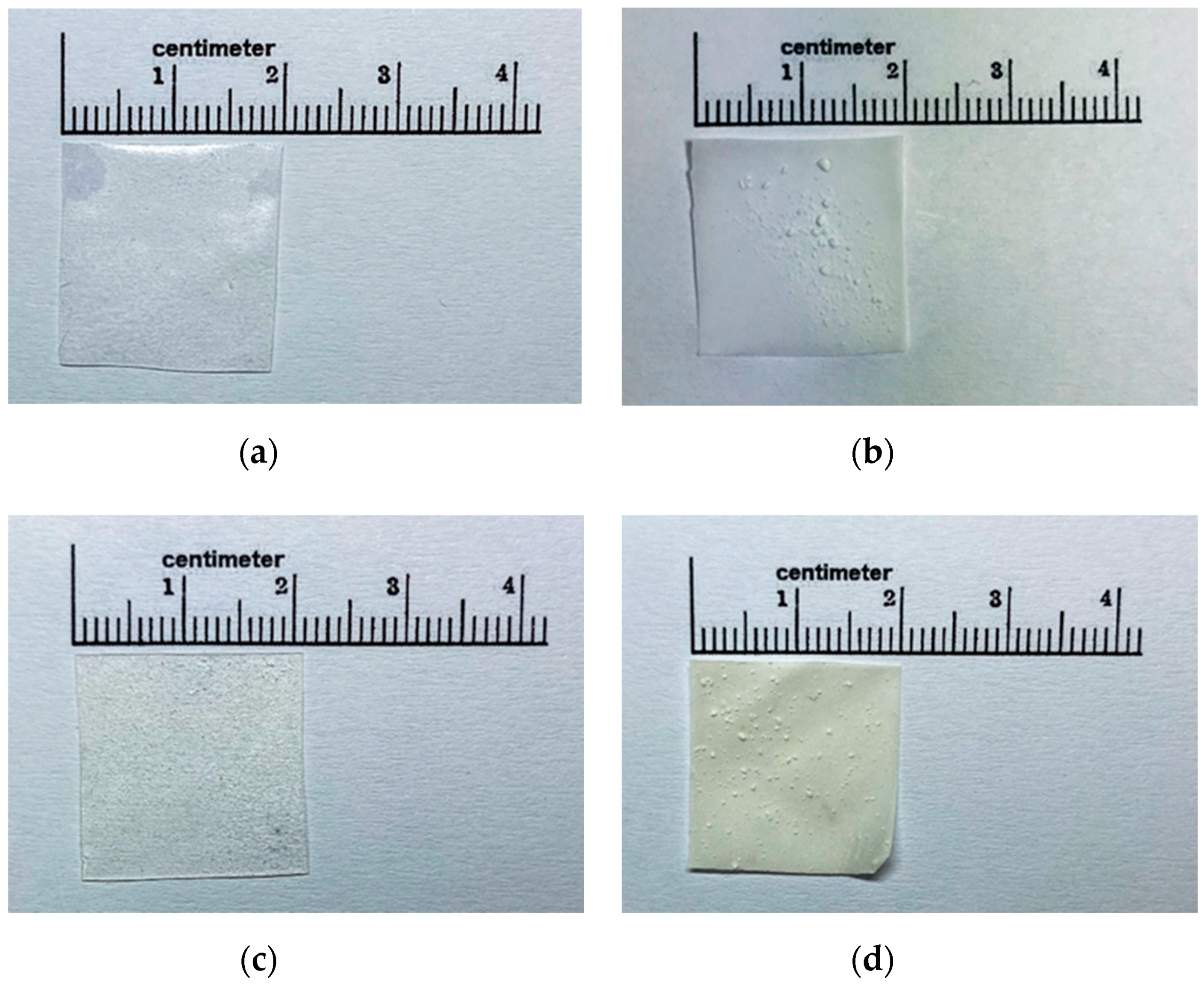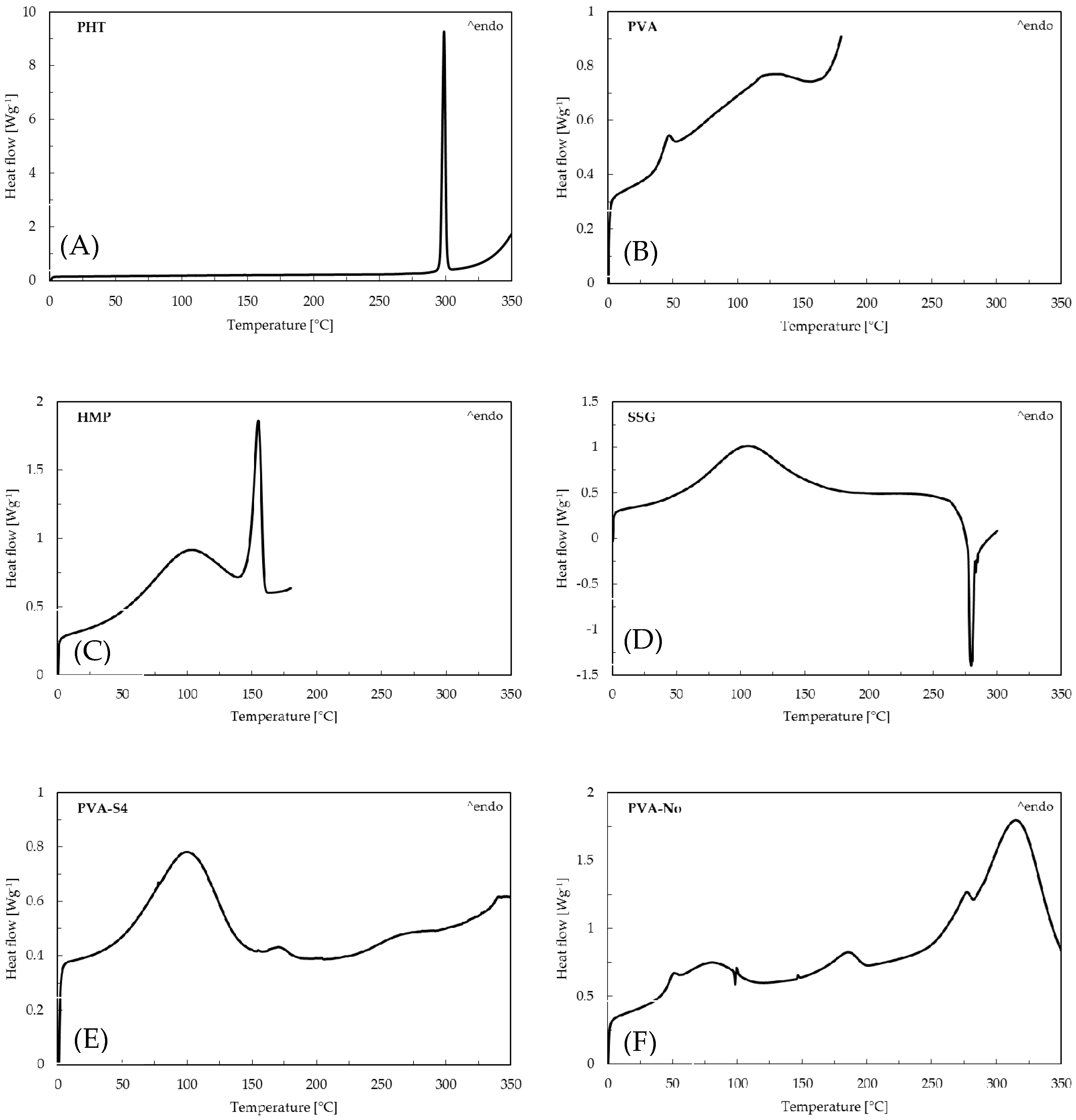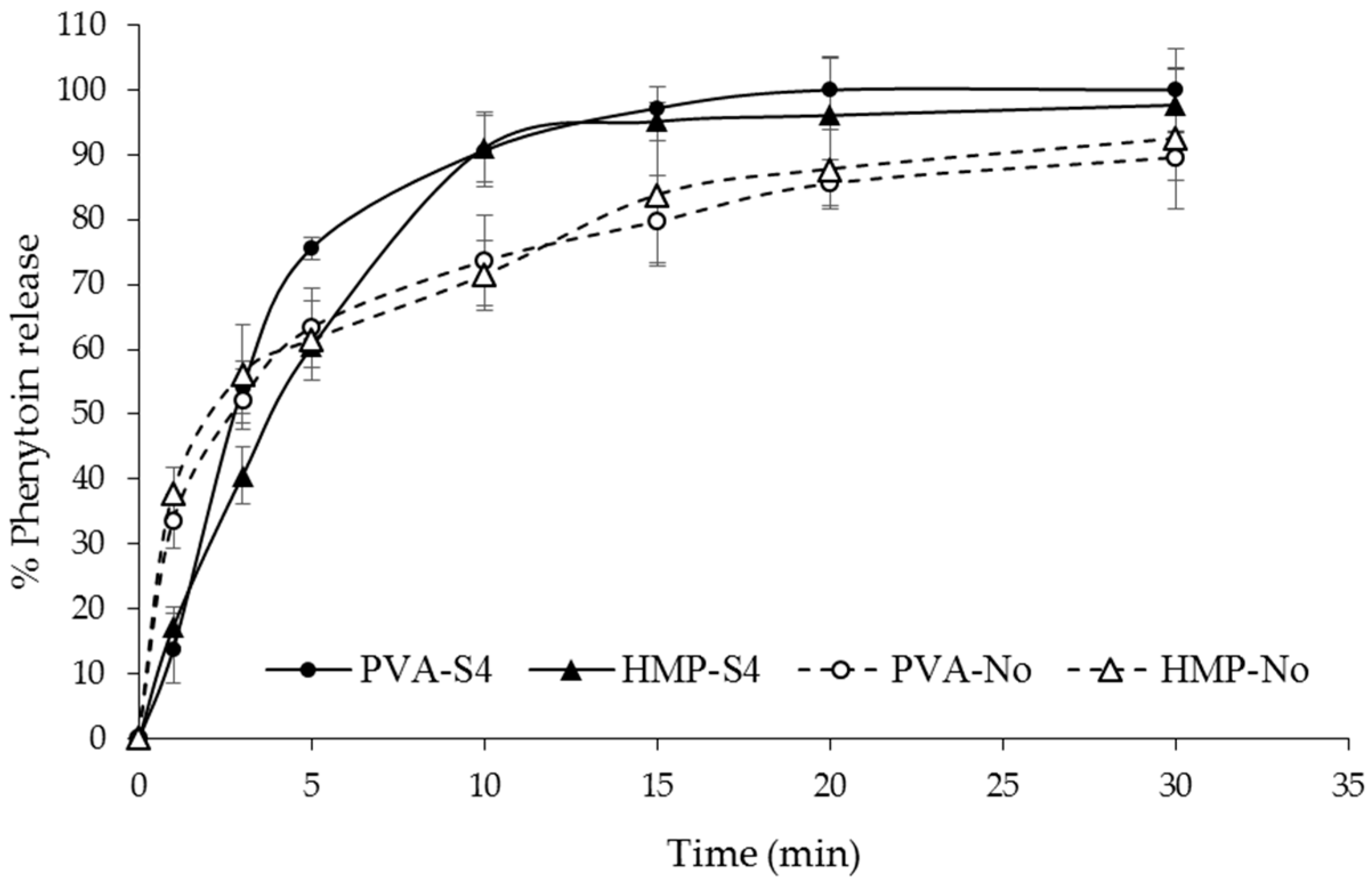Formulation of Orally Disintegrating Films as an Amorphous Solid Solution of a Poorly Water-Soluble Drug
Abstract
1. Introduction
2. Materials and Methods
2.1. Materials
2.2. Cosolvency
2.3. Preparation of Phenytoin ODFs
2.4. Evaluation Parameters of Phenytoin ODFs
2.4.1. Weight Variation
2.4.2. Thickness Uniformity
2.4.3. Surface pH
2.4.4. Mechanical Strength Test
2.5. In Vitro Disintegration Time
2.6. Determination of Moisture Content
2.7. Measurement of Film Porosity
2.8. Phenytoin Content
2.9. Differential Scanning Calorimetry (DSC)
2.10. X-ray Diffraction (XRD)
2.11. In Vitro Release Study
2.12. Statistical Analysis
3. Results and Discussion
3.1. Phenytoin Solubility in Mixed-Solvent Systems
3.2. Film Preparation and Characterization
3.3. Mechanical Properties of Phenytoin ODFs
3.4. Disintegration Time
3.5. Phenytoin Loading Content
3.6. Differential Scanning Calorimetry (DSC)
3.7. X-ray Diffraction (XRD) Studies
3.8. In Vitro Phenytoin Release Studies
4. Conclusions
Supplementary Materials
Author Contributions
Funding
Acknowledgments
Conflicts of Interest
References
- Singh, A.; Trevick, S. The epidemiology of global epilepsy. Neurol. Clin. 2016, 34, 837–847. [Google Scholar] [CrossRef]
- Stafstrom, C.E.; Carmant, L. Seizures and epilepsy: An overview for neuroscientists. Cold Spring Harb. Perspect. Med. 2015, 5, a022426. [Google Scholar] [CrossRef]
- Gaínza-Lein, M.; Fernández, I.S.; Jackson, M.; Abend, N.S.; Arya, R.; Brenton, J.N.; Goldstein, J.L. Association of time to treatment with short-term outcomes for pediatric patients with refractory convulsive status epilepticus. JAMA Neurol. 2018, 75, 410–418. [Google Scholar] [CrossRef]
- Beyenburg, S.; Bauer, J.; Reuber, M. New drugs for the treatment of epilepsy: A practical approach. Postgrad. Med. J. 2004, 80, 581–587. [Google Scholar] [CrossRef]
- Phenytoin, Package Insert. Available online: http://media.pfizer.com/files/products/uspi_dilantin.pdf (accessed on 25 January 2020).
- Nagar, P.; Chauhan, I.; Yasir, M. Insights into polymers: Film formers in mouth dissolving films. Drug Invent. Today 2011, 3, 56–73. [Google Scholar]
- Preis, M.; Pein, M.; Breitkreutz, J. Development of a taste-masked orodispersible film containing dimenhydrinate. Pharmaceutics 2012, 4, 551–562. [Google Scholar] [CrossRef] [PubMed]
- Wasilewska, K.; Winnicka, K. How to assess orodispersible film quality? A review of applied methods and their modifications. Acta Pharm. 2019, 69, 155–176. [Google Scholar] [CrossRef] [PubMed]
- Lam, J.K.; Xu, Y.; Worsley, A.; Wong, I.C. Oral transmucosal drug delivery for pediatric use. Adv. Drug Deliv. Rev. 2014, 73, 50–62. [Google Scholar] [CrossRef] [PubMed]
- Mashru, R.C.; Sutariya, V.B.; Sankalia, M.G.; Parikh, P.P. Development and evaluation of fast-dissolving film of salbutamol sulphate. Drug Dev. Ind. Pharm. 2005, 31, 25–34. [Google Scholar] [CrossRef] [PubMed]
- Newton, A.M.J.; Rani, S.M.; Sukhjinder, K. Fabrication and evaluation of fast disintegrating oral hybrid films of propranolol hydrochloride by using pectin and synthetic polymers. J. Dev. Drugs 2016, 5, 157. [Google Scholar]
- Deshmukh, A.S.; Tiwari, K.J.; Mahajan, V.R. Solubility enhancement techniques for poorly water-soluble drugs. Int. J. Pharm. Sci. Nanotechnol. 2017, 10, 3701–3708. [Google Scholar]
- Desai, P.M.; Liew, C.V.; Heng, P.W.S. Review of disintegrants and the disintegration phenomena. J. Pharm. Sci. 2016, 105, 2545–2555. [Google Scholar] [CrossRef] [PubMed]
- Yellanki, S.K.; Jagtap, S.; Masareddy, R. Dissofilm: A novel approach for delivery of phenobarbital; design and characterization. J. Young Pharm. 2011, 3, 181–188. [Google Scholar] [CrossRef] [PubMed]
- National Center for Biotechnology Information. PubChem Database, Phenytoin, CID=1775. Available online: https://pubchem.ncbi.nlm.nih.gov/compound/Phenytoin (accessed on 27 March 2020).
- Preis, M.; Knop, K.; Breitkreutz, J. Mechanical strength test for orodispersible and buccal films. Int. J. Pharm. 2014, 461, 22–29. [Google Scholar] [CrossRef] [PubMed]
- Morales, J.O.; McConville, J.T. Manufacture and characterization of mucoadhesive buccal films. Eur. J. Pharm. Biopharm. 2011, 77, 187–199. [Google Scholar] [CrossRef]
- Guhmann, M.; Preis, M.; Gerber, F.; Pollinger, N.; Breikreutz, J.; Weitschies, W. Development of oral taste masked diclofenac formulations using a taste sensing system. Int. J. Pharm. 2012, 438, 81–90. [Google Scholar] [CrossRef]
- Thimmaiah, P.C.; Panda, A.K.; Pandey, U.K.; McCague, C.; Dutta, P.; Bahrami, M. A new approach to compute the porosity and surface roughness of porous coated capillary-assisted low pressure evaporators. Sci. Rep. 2018, 8, 1–11. [Google Scholar]
- USP. The United States Pharmacopeia, 41st ed. In Proceedings of the United States Pharmacopeial Convention, Rockville, MD, USA, 9 April 2018; p. 3286. [Google Scholar]
- Chaudhary, A.; Nagaich, U.; Gulati, N.; Sharma, V.K.; Khosa, R.L.; Partapur, M.U. Enhancement of solubilization and bioavailability of poorly soluble drugs by physical and chemical modifications: A recent review. J. Adv. Pharm. Educ. Res. 2012, 2, 32–67. [Google Scholar]
- Babu, P.S.; Subrahmanyam, C.V.S.; Thimmasetty, J.; Manavalan, R.; Valliappan, K.; Kedarnath, S.A. Solubility enhancement of cox-II inhibitors by cosolvency approach. Dhaka Univ. J. Pharm. Sci. 2008, 7, 119–126. [Google Scholar] [CrossRef]
- Jouyban, A. Handbook of Solubility Data for Pharmaceuticals, 1st ed.; CRC Press: Boca Raton, FL, USA, 2010; p. 32. [Google Scholar]
- Bunker, A. Poly (ethylene glycol) in drug delivery, why does it work, and can we do better? All atom molecular dynamics simulation provides some answers. Phys. Procedia 2012, 34, 24–33. [Google Scholar] [CrossRef]
- Lingam, M.; Venkateswarlu, V. Enhancement of solubility and dissolution rate of poorly water soluble drug using cosolvency and solid dispersion techniques. Int. J. Pharm. Sci. Nanotechnol. 2009, 1, 349–356. [Google Scholar]
- Nagaraju, T.; Gowthami, R.; Rajashekar, M.; Sandeep, S.; Mallesham, M.; Sathish, D.; Shravan Kumar, Y. Comprehensive review on oral disintegrating films. Curr. Drug Deliv. 2013, 10, 96–108. [Google Scholar] [CrossRef]
- Visakh, P.M.; Markovic, G.; Pasquini, D. (Eds.) Applications of thermoplastic-based blends. In Recent Developments in Polymer Macro, Micro and Nano Blends: Preparation and Characterisation; Woodhead Publishing: Sawston, Cambridge, UK, 2016; p. 113. [Google Scholar]
- Sundar Raj, A.A.; Rubila, S.; Jayabalan, R.; Ranganathan, T.V. A review on pectin: Chemistry due to general properties of pectin and its pharmaceutical uses. Sci. Rep. 2012, 1, 550–551. [Google Scholar]
- Singh, S.; Jain, S.; Muthu, M.S.; Tiwari, S.; Tilak, R. Preparation and evaluation of buccal bioadhesive films containing clotrimazole. AAPS Pharmscitech. 2008, 9, 660–667. [Google Scholar] [CrossRef] [PubMed]
- Murrieta-Martínez, C.; Soto-Valdez, H.; Pacheco-Aguilar, R.; Torres-Arreola, W.; Rodríguez-Felix, F.; Ramírez-Wong, B.; Márquez-Ríos, E. Effect of different polyalcohols as plasticizers on the functional properties of squid protein film (Dosidicus gigas). Coatings 2019, 9, 77. [Google Scholar] [CrossRef]
- Jantrawut, P.; Chaiwarit, T.; Jantanasakulwong, K.; Brachais, C.H.; Chambin, O. Effect of plasticizer type on tensile property and in vitro indomethacin release of thin films based on low-methoxyl pectin. Polymers 2017, 9, 289. [Google Scholar] [CrossRef] [PubMed]
- Sanyang, M.L.; Sapuan, S.M.; Jawaid, M.; Ishak, M.R.; Sahari, J. Effect of plasticizer type and concentration on physical properties of biodegradable films based on sugar palm (Arenga pinnata) starch for food packaging. J. Food Sci. Technol. 2016, 53, 326–336. [Google Scholar] [CrossRef] [PubMed]
- Sobral, P.D.A.; Menegalli, F.C.; Hubinger, M.D.; Roques, M.A. Mechanical, water vapor barrier and thermal properties of gelatin based edible films. Food Hydrocoll. 2001, 15, 423–432. [Google Scholar] [CrossRef]
- Pradhan, D.K.; Choudhary, R.N.P.; Samantaray, B.K.; Karan, N.K.; Katiyar, R.S. Effect of plasticizer on structural and electrical properties of polymer nanocompsoite electrolytes. Int. J. Electrochem. Sci. 2007, 2, 861–871. [Google Scholar]
- Fernández-Pan, I.; Ziani, K.; Pedroza-Islas, R.; Maté, J.I. Effect of drying conditions on the mechanical and barrier properties of films based on chitosan. Dry. Technol. 2010, 28, 1350–1358. [Google Scholar] [CrossRef]
- Touil, A.; Chemkhi, S.; Zagrouba, F. Moisture diffusivity and shrinkage of fruit and cladode of Opuntia ficus-indica during infrared drying. J. Food Process. 2014, 2014. [Google Scholar] [CrossRef]
- Gohel, M.C.; Parikh, R.K.; Brahmbhatt, B.K.; Shah, A.R. Preparation and assessment of novel coprocessed superdisintegrant consisting of crospovidone and sodium starch glycolate: A technical note. AAPS PharmSciTech 2007, 8, E63. [Google Scholar] [CrossRef] [PubMed]
- Jani, R.; Patel, D. Hot melt extrusion: An industrially feasible approach for casting orodispersible film. Asian J. Pharm. Sci. 2015, 10, 292–305. [Google Scholar] [CrossRef]
- Jamróz, W.; Kurek, M.; Łyszczarz, E.; Szafraniec, J.; Knapik-Kowalczuk, J.; Syrek, K.; Jachowicz, R. 3D printed orodispersible films with Aripiprazole. Int. J. Pharm. 2017, 533, 413–420. [Google Scholar] [CrossRef] [PubMed]
- Hassel, T.M. 3. Phenytoin: Chemistry, disposition and metabolism. In Epilepsy and the Oral Manifestations of Phenytoin Therapy; Karger Publishers: Basel, Switzerland, 1981; pp. 60–69. [Google Scholar]
- Qamar, N.; Abbas, N.; Irfan, M.; Hussain, A.; Arshad, M.S.; Latif, S.; Ghori, M.U. Personalized 3D printed ciprofloxacin impregnated meshes for the management of hernia. J. Drug Deliv. Sci. Technol. 2019, 53, 101164. [Google Scholar] [CrossRef]
- Aburto, J.; Moran, M.; Galano, A.; Torres-García, E. Non-isothermal pyrolysis of pectin: A thermochemical and kinetic approach. J. Anal. Appl. Pyrolysis 2015, 112, 94–104. [Google Scholar] [CrossRef]
- Feng, X.; Ye, X.; Park, J.B.; Lu, W.; Morott, J.; Beissner, B.; Durig, T. Evaluation of the recrystallization kinetics of hot-melt extruded polymeric solid dispersions using an improved Avrami equation. Drug Dev. Ind. Pharm. 2015, 41, 1479–1487. [Google Scholar] [CrossRef]
- Franco, M.; Trapani, G.; Latrofa, A.; Tullio, C.; Provenzano, M.R.; Serra, M.; Liso, G. Dissolution properties and anticonvulsant activity of phenytoin-polyethylene glycol 6000 and-polyvinylpyrrolidone K-30 solid dispersions. Int. J. Pharm. 2001, 225, 63–73. [Google Scholar] [CrossRef]
- Frank, K.J.; Rosenblatt, K.M.; Westedt, U.; Hölig, P.; Rosenberg, J.; Mägerlein, M.; Brandl, M. Amorphous solid dispersion enhances permeation of poorly soluble ABT-102: True supersaturation vs. apparent solubility enhancement. Int. J. Pharm. 2012, 437, 288–293. [Google Scholar] [CrossRef]
- Miller, J.M.; Beig, A.; Carr, R.A.; Spence, J.K.; Dahan, A. A win–win solution in oral delivery of lipophilic drugs: Supersaturation via amorphous solid dispersions increases apparent solubility without sacrifice of intestinal membrane permeability. Mol. Pharm. 2012, 9, 2009–2016. [Google Scholar] [CrossRef]
- Hassan, S.; Adam, F.; Abu Bakar, M.R.; Abdul Mudalip, S.K. Evaluation of solvents’ effect on solubility, intermolecular interaction energies and habit of ascorbic acid crystals. J. Saudi Chem. Soc. 2019, 23, 239–248. [Google Scholar] [CrossRef]
- Yadav, A.V.; Shete, A.S.; Dabke, A.P.; Kulkarni, P.V.; Sakhare, S.S. Co-crystals: A novel approach to modify physicochemical properties of active pharmaceutical ingredients. Indian J. Pharm. Sci. 2009, 71, 359–370. [Google Scholar] [CrossRef] [PubMed]
- Hancock, B.C.; Zografi, G. Characteristics and significance of the amorphous state in pharmaceutical systems. J. Pharm. Sci. 1997, 86, 1–12. [Google Scholar] [CrossRef] [PubMed]
- Radacsi, N.; Campos, F.D.; Chisholm, C.R.; Giapis, K.P. Spontaneous formation of nanoparticles on electrospun nanofibres. Nat. Commun. 2018, 9, 1–8. [Google Scholar] [CrossRef]
- Daly, D.T.; Spear, S.K.; Swatloski, R.P. Pectin Compounds, Methods of Using Pectin Compounds, and Methods of Controlling Water Solubility. U.S. Patent 13,384,404, 15 November 2012. [Google Scholar]
- Thomason, J.L.; Vlug, M.A.; Schipper, G.; Krikor, H.G.L.T. Influence of fibre length and concentration on the properties of glass fibre-reinforced polypropylene: Part 3. Strength and strain at failure. Compos. Part. A Appl. Sci. Manuf. 1996, 27, 1075–1084. [Google Scholar] [CrossRef]
- Hassan, C.M.; Trakampan, P.; Peppas, N.A. Water solubility characteristics of poly (vinyl alcohol) and gels prepared by freezing/thawing processes. In Water Soluble Polymers; Amjad, Z., Ed.; Springer: Boston, MA, USA, 2002; pp. 31–40. [Google Scholar]
- Chan, L.W.; Hao, J.S.; Heng, P.W.S. Evaluation of permeability and mechanical properties of composite polyvinyl alcohol films. Chem. Pharm. Bull. 1999, 47, 1412–1416. [Google Scholar] [CrossRef]





| Formulation Code | Polymer (%w/w) | SSG (%w/w) | Phenytoin (%w/w) | Cosolvent System (%w/w) | Water | |||
|---|---|---|---|---|---|---|---|---|
| PVA | HMP | PEG | Glycerin | Water | qs to | |||
| PVA-S0 | 1 | - | - | 0.45 | 6.76 | 1.12 | 1.12 | 100 |
| PVA-S4 | 1 | - | 0.04 | 0.45 | 6.76 | 1.12 | 1.12 | 100 |
| PVA-S8 | 1 | - | 0.08 | 0.45 | 6.76 | 1.12 | 1.12 | 100 |
| PVA-No | 1 | - | - | 0.45 | - | - | - | 100 |
| HMP-S0 | - | 1 | - | 0.45 | 6.76 | 1.12 | 1.12 | 100 |
| HMP-S4 | - | 1 | 0.04 | 0.45 | 6.76 | 1.12 | 1.12 | 100 |
| HMP-S8 | - | 1 | 0.08 | 0.45 | 6.76 | 1.12 | 1.12 | 100 |
| HMP-No | - | 1 | - | 0.45 | - | - | - | 100 |
| PH-S0 | 0.5 | 0.5 | - | 0.45 | 6.76 | 1.12 | 1.12 | 100 |
| PH-S4 | 0.5 | 0.5 | 0.04 | 0.45 | 6.76 | 1.12 | 1.12 | 100 |
| PH-S8 | 0.5 | 0.5 | 0.08 | 0.45 | 6.76 | 1.12 | 1.12 | 100 |
| Cosolvent (%v/v) | Water (%v/v) | Dielectric Constant | Solubility of Phenytoin (mg/mL) | ||
|---|---|---|---|---|---|
| Water–PEG | Water–Ethanol | In Water–PEG | In Water–Ethanol | ||
| 100 | 0 | 12.40 | 24.30 | 26.52 | 18.54 |
| 90 | 10 | 19.00 | 29.71 | 26.36 | 18.16 |
| 80 | 20 | 25.59 | 35.11 | 26.69 | 15.77 |
| 70 | 30 | 32.19 | 40.52 | 21.21 | 11.11 |
| 60 | 40 | 38.78 | 45.92 | 10.17 | 7.62 |
| 50 | 50 | 45.38 | 51.33 | 3.91 | 4.86 |
| 40 | 60 | 51.98 | 56.74 | 2.60 | 2.19 |
| 30 | 70 | 58.57 | 62.14 | 0.24 | 1.42 |
| 20 | 80 | 65.17 | 67.55 | ND | ND |
| 10 | 90 | 71.76 | 72.95 | ND | ND |
| 0 | 100 | 78.36 | 78.36 | ND | ND |
| Film | Weight (g ± SD) | Thickness (mm ± SD) | Surface pH |
|---|---|---|---|
| PVA-S0 | 0.1090 ± 0.0057 a | 0.213 ± 0.008 a | 7.26 ± 0.11 a |
| PVA-S4 | 0.1063 ± 0.0051 a | 0.203 ± 0.039 a | 7.47 ± 0.17 a |
| PVA-S8 | 0.1083 ± 0.0019 a | 0.232 ± 0.012 a | 7.52 ± 0.18 a |
| PVA-No | 0.0141 ± 0.0011 b | 0.084 ± 0.042 b | 7.44 ± 0.10 a |
| HMP-S0 | 0.1106 ± 0.0023 a | 0.226 ± 0.005 a | 4.90 ± 0.32 b |
| HMP-S4 | 0.1079 ± 0.0038 a | 0.234 ± 0.010 a | 4.36 ± 0.12 b |
| HMP-S8 | 0.1151 ± 0.0070 c | 0.244 ± 0.010 a | 4.67 ± 0.05 b |
| HMP-No | 0.0160 ± 0.0015 b | 0.106 ± 0.008 b | 3.71 ± 0.12 c |
| PH-S0 | 0.1170 ± 0.0018 c | 0.238 ± 0.009 a | 5.24 ± 0.02 d |
| PH-S4 | 0.1165 ± 0.0007 c | 0.242 ± 0.003 a | 5.31 ± 0.09 d |
| PH-S8 | 0.1239 ± 0.0047 c | 0.251 ± 0.017 a | 5.64 ± 0.02 d |
| Film | Puncture Strength (N/mm2) | Young’s Modulus (N/mm2) | Disintegration Time (min) | Normalized Disintegration Time (min) |
|---|---|---|---|---|
| PVA-S0 | 0.15 ± 0.02 a | 4.12 ± 0.61 a | 2.68 ± 0.23 a | 3.15 ± 0.26 a |
| PVA-S4 | 0.14 ± 0.01 a | 2.05 ± 0.22 a | 1.44 ± 0.26 b | 1.78 ± 0.32 b |
| PVA-S8 | 0.14 ± 0.01 a | 2.12 ± 0.16 a | 2.38 ± 0.25 a | 2.57 ± 0.27 a |
| PVA-No | 2.47 ± 0.20 b | 203.88 ± 37.99 b | 0.33 ± 0.04 c | 0.99 ± 0.14 c |
| HMP-S0 | 0.33 ± 0.03 a | 19.11 ± 2.32 a | 3.35 ± 0.62 d | 3.72 ± 0.69 d |
| HMP-S4 | 0.39 ± 0.05 a | 12.14 ± 1.36 a | 1.62 ± 0.06 b | 1.74 ± 0.07 b |
| HMP-S8 | 0.43 ± 0.04 a | 12.84 ± 1.20 a | 2.14 ± 0.71 a | 2.19 ± 0.73 b |
| HMP-No | 1.82 ± 0.36 c | 120.86 ± 20.16 b | 0.33 ± 0.01 c | 0.76 ± 0.01 c |
| PH-S0 | 0.30 ± 0.04 a | 14.35 ± 1.01 a | 2.75 ± 0.04 a | 2.90 ± 0.05 a |
| PH-S4 | 0.29 ± 0.02 a | 7.02 ± 1.02 a | 2.08 ± 0.24 a | 2.15 ± 0.24 b |
| PH-S8 | 0.30 ± 0.03 a | 7.05 ± 1.62 a | 2.54 ± 0.09 a | 2.54 ± 0.09 a |
Publisher’s Note: MDPI stays neutral with regard to jurisdictional claims in published maps and institutional affiliations. |
© 2020 by the authors. Licensee MDPI, Basel, Switzerland. This article is an open access article distributed under the terms and conditions of the Creative Commons Attribution (CC BY) license (http://creativecommons.org/licenses/by/4.0/).
Share and Cite
Panraksa, P.; Tipduangta, P.; Jantanasakulwong, K.; Jantrawut, P. Formulation of Orally Disintegrating Films as an Amorphous Solid Solution of a Poorly Water-Soluble Drug. Membranes 2020, 10, 376. https://doi.org/10.3390/membranes10120376
Panraksa P, Tipduangta P, Jantanasakulwong K, Jantrawut P. Formulation of Orally Disintegrating Films as an Amorphous Solid Solution of a Poorly Water-Soluble Drug. Membranes. 2020; 10(12):376. https://doi.org/10.3390/membranes10120376
Chicago/Turabian StylePanraksa, Pattaraporn, Pratchaya Tipduangta, Kittisak Jantanasakulwong, and Pensak Jantrawut. 2020. "Formulation of Orally Disintegrating Films as an Amorphous Solid Solution of a Poorly Water-Soluble Drug" Membranes 10, no. 12: 376. https://doi.org/10.3390/membranes10120376
APA StylePanraksa, P., Tipduangta, P., Jantanasakulwong, K., & Jantrawut, P. (2020). Formulation of Orally Disintegrating Films as an Amorphous Solid Solution of a Poorly Water-Soluble Drug. Membranes, 10(12), 376. https://doi.org/10.3390/membranes10120376






